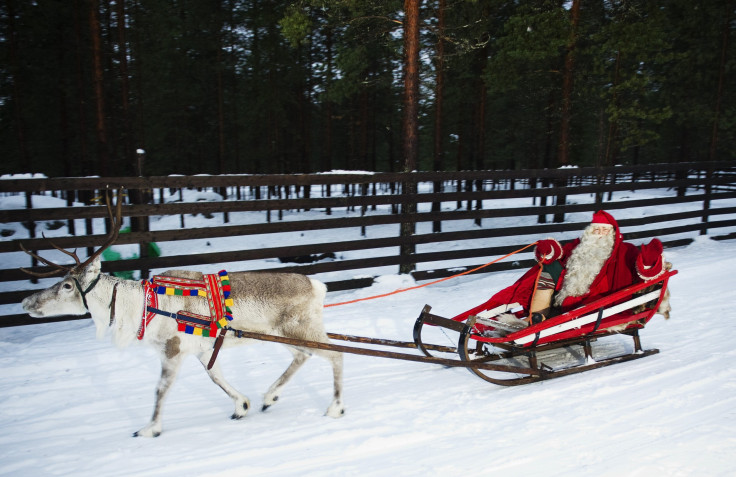How’s Your Christmas History? Here Are 9 Facts You Might Not Know
There are only five more days until Christmas, so it's a good time to test your knowledge of the holiday.
A Gallop Poll from last year estimated that nearly everyone in the U.S. celebrates the day in one way or another. But do you know your history?
For those adhering to a Christian theology, the Pew Research Center found that 96% of Americans observe the holiday. For those who say religion isn’t that important to them, the figure dropped to 85% -- still a sizeable majority for a religious holiday.
From the original date of the birth of Jesus to the true origins of Santa Claus, here are nine things you might not know about the upcoming holiday.
No. 9: Christmas is not the most important holiday on the Christian calendar.
That distinction goes to Pascha, or Easter. That’s when Christians celebrate the resurrection of Jesus. In his first letter to the Corinthians, a Christian community in what is now southern Greece, the apostle Paul writes the resurrection is “of the first importance.”
If Christ were not raised from the dead, Paul continues, “our preaching is useless and so is your faith”
No. 8: Why is Christmas on Dec. 25?
The holiday season marks the peak sales season for retailers and thus the tradition has become something of a corporate staple. Early Christian theologians, however, likely chose Dec. 25 because it lined up with pagan holidays marking the winter solstice, the day with the least amount of sunlight.
Christmas is meant to mark the birth of Jesus, though his real birthdate is a subject of debate. Writing in the fourth century, St. Augustine formally aligned the solstice with the birth of Jesus by writing “He was born on the day which is the shortest in our earthly reckoning.”
No. 7: The birth date of Jesus
The New Testament focuses more on theology than historical records. The apostle Matthew wrote that Jesus was born during the reign of King Herod the Great, who ruled from about 37 B.C. to 4 A.D.
Luke, for his part, writes that Jesus was born at a time when shepherds were “living out in the fields, keeping watch over their flock by night.” Given the regional climate, that would put the birthdate of Jesus no later than October because livestock would be sheltered inside during the colder winter months.
No. 6: Xmas is a no-no
There is a common misconception that “Xmas” is sacrilegious because it takes the “Christ” out of “Christmas.” That is incorrect. According to the Online Etymology Dictionary, which delves into the history of words, “Xmas” dates back to at least the 1500s. The “X” is actually an abbreviation for Christ.
The English letter “X” looks, but doesn't sound, like the Greek letter “chi,” the first letter in the Greek word for Christ, “Christos.”
No. 5: Star of Bethlehem
The Book of Numbers, the fourth book in the Hebrew bible, predicts a star would rise from Israel to tell of the arrival of a new prophet. The Gospel of Matthew recounts a visit to Jesus in Jerusalem from “wise men” who said they had “seen His star in the East and have come to worship Him.”
It’s unclear if there was a celestial event that coincided with the birth. A survey by astronomer Michael Molnar of an ancient coin depicting an astrological event suggests Jupiter was eclipsed twice by the moon in the spring of 6 B.C. In particular, he writes that astrological conditions in April that year “were believed to herald the birth of a divine, immortal, and omnipotent person born under the sign of the Jews, which we now know was Aries the Ram.”
No. 4: Were there really three wise men?
Of the four gospels from Matthew, Mark, Luke and John, only Matthew describes the visitation of magi to Jerusalem. Matthew makes no reference to a specific number of visitors, but it’s widely believed to be three because he recounts the presentation of the “gifts of gold, frankincense and myrrh.”
The term “magi,” meaning magicians or astrologers, may be a reference to practitioners of the ancient religion of Zoroastrianism from Persia, which would explain their arrival from the east.
No. 3: On Donner and Blitzen?
Santa’s eight flying reindeer were introduced first in the 1823 poem by Clement Clarke Moore entitled “A Visit from St. Nicholas,” otherwise known as ‘Twas the Night Before Christmas.
The original text reads “Now, Dasher! Now, Dancer! Now Prancer and Vixen! On, Comet! On, Cupid! On, Donder, and Blitzen!
Donder in Dutch means “Thunder.” In German, it’s “Donner.” The latter was cemented in popular culture in the 1938 book “Rudolph the Red Nosed Reindeer” and later in 1949 when Gene Autry recorded a song of the same name.

No. 2: Away in the manger
Biblical accounts of the birth of Jesus note he was not born in a manger, but laid in one in swaddling clothes. In the gospel of Luke, he was laid in the manger because “there was no place for them in the inn.”
Does that mean Jesus was born in a barn? Not necessarily. Inn, according to etymology, references a “public house with lodging,” and considering the pastoral life of ancient Jerusalem, it was common to have mangers, a type of feeding trough, at the ground level of a dwelling. By one account, it’s likely that Jesus, Mary and Joseph were there to avoid crowding on an upper level.
No. 1: Is that you, Santa Claus?
Coca-Cola did not “invent” Santa, as popular legend holds. Instead, he was first St. Nicholas, or Nicholas of Bari, a Christian bishop working around 300 A.D. As with other early Christian saints, Nicholas was known for secret gift-gifting. In one narrative, he helped a family avoid putting their daughters into prostitution by throwing gold coins in their window at night.
Sinterklaas in the Dutch language is in reference to St. Nicholas, which later became Santa Claus. One of the earliest depictions of Santa Claus as an older, heavy-set man came from Thomas Nast, who made illustrations of what’s recognized as the modern image of Santa for Harper’s Weekly in the mid-19th century.
Addressing his existence, The Sun newspaper in New York, which published from 1833 to 1950, told one inquiring child, Virginia O’Hanlon, that “Yes, Virginia, there is a Santa Claus” in 1897.
“He exists as certainly as love and generosity and devotion exist,” the editors wrote.

© Copyright IBTimes 2024. All rights reserved.





















